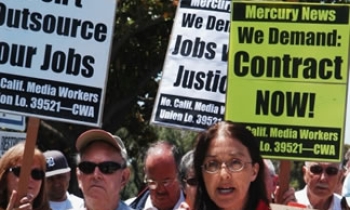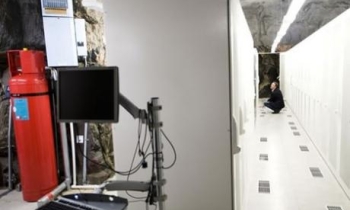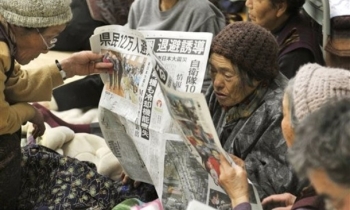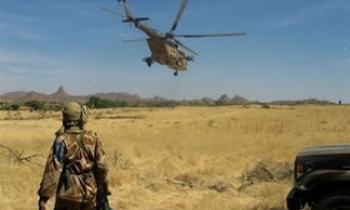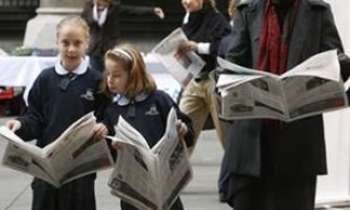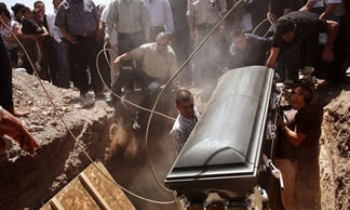Tehran – Iran's supreme leader on Tuesday denounced as an Israeli conspiracy the publication of caricatures of Islam's prophet in Western newspapers.
Ayatollah Ali Khamenei told Iranian Air Force personnel the cartoons were particularly scandalous as they came "from those who champion civilization and free expression."
The cartoons of the Prophet Mohammed have led to demonstrations, boycotts and attacks on European embassies across the Islamic world.
They were first published in Denmark in September and then reprinted recently by numerous European newspapers in the name of free expression.
"The West condemns any denial of the Jewish holocaust, but it permits the insult of Islamic sanctities," Khamenei said.
The cartoons have offended many Muslims because most Islamic teachers forbid any illustration of the prophet and because several drawings depict Mohammed as a man of violence.
The caricatures amounted to a "conspiracy by Zionists who were angry because of the victory of Hamas," he said, referring to the Palestinian militant group that won a surprise landslide victory in last month's elections.
On Monday, hundreds of angry protesters hurled stones and fire bombs at the Danish embassy in the Iranian capital to protest publication of the caricatures. Police used tear gas and surrounded the walled villa to hold back the crowd.
It was the second attack on a Western mission in Tehran on Monday. Earlier in the day, 200 student demonstrators threw stones at the Austrian Embassy, breaking windows and starting small fires. The mission was targeted because Austria holds the presidency of the European Union.
Thousands more people joined violent demonstrations across the world to protest publication of the caricatures of Mohammed, and the Bush administration appealed to Saudi Arabia to use its influence among Arabs to help ease tensions in the Middle East and Europe.
Thousands of rioters clashed with police and NATO peacekeepers across Afghanistan on Tuesday in demonstrations against the publication of the cartoons, officials said. One person was killed and scores wounded.
Norwegian troops fired on hundreds of protesters outside their base in Maymana, a city in the northwest, after the demonstrators shot at them and threw grenades, said provincial Governor Mohammed Latif. One of the demonstrators was shot dead while two others were wounded, he said.
A spokeswoman for NATO's peacekeeping force, Squadron Leader Annie Gibson-Sexton, said troops used tear gas against the protesters, but could not confirm that shots had been fired. She said there were no reports of injuries among the Norwegian troops.
On Monday, Afghan troops shot and killed four protesters, some as they tried to storm a U.S. military base outside Bagram – the first time a protest over the issue has targeted the United States. A teenage boy was killed when protesters stampeded in Somalia.
The EU issued stern reminders to 18 Arab and other Muslim countries that they are under treaty obligations to protect foreign embassies.
Lebanon apologized to Denmark – where the cartoons were first published – a day after protesters set fire to a building housing the Danish mission in Beirut. The attack "harmed Lebanon's reputation and its civilized image," Lebanese Information Minister Ghazi Aridi said.
In the Iranian capital, police encircled the Danish Embassy but were unable to hold back 400 demonstrators as they tossed stones and Molotov cocktails at the walled brick villa. At least nine protesters were hurt, police said.
About an hour into the protest, police fired tear gas, driving the demonstrators into a nearby park. Later, about 20 people returned and tried to break through police lines to enter the embassy compound but were blocked by security forces.
As the tear gas dissipated, most of the crowd filtered back to the embassy, where they burned Danish flags and chanted anti-Danish slogans and "God is great."
Two trees inside the embassy compound were set on fire by the gasoline bombs. The embassy gate was burned, as was a police booth along the wall protecting the building.
The Danish Foreign Ministry said it was not aware of any staff inside the building, which closed for the day before the demonstration.
Ambassador Claus Juul Nielsen told DR public television in Denmark that the protesters vandalized the ground floor of the embassy, which included the trade and the visa departments.
The crowd, which included about 100 women, ignored police orders to disperse and kept hurling fire bombs until being hit by tear gas. The crowd dispersed by midnight.
Also Monday, 200 members of Iran's parliament issued a statement warning that those who published the cartoons should remember the case of Salman Rushdie – the British author against whom the late Iranian leader Ayatollah Ruhollah Khomeini issued a death warrant for his novel The Satanic Verses.
The angry demonstrations in Iran recall the Nov. 4, 1979, seizure of the American Embassy in Tehran after the Islamic revolution that overthrew U.S. ally Shah Mohammad Reza Pahlavi.
The students who held 52 Americans hostage for 444 days faced little or no police resistance in the post-revolutionary turmoil that had brought Shiite theologian Ayatollah Ruhollah Khomeini and an Islamic government to power.
There has been a wave of protests across the Islamic world over caricatures first published in September by a Danish paper. They have since been reprinted by other media, mostly in Europe.
The drawings – including one depicting the prophet wearing a turban shaped as a bomb – have touched a raw nerve in part because Islamic law forbids any illustrations of the Prophet Mohammed for fear they could lead to idolatry.
In a meeting with local authors, Iranian President Mahmoud Ahmadinejad condemned the cartoons and addressed the West: "Insulting the Prophet Mohammed would not promote your position," the official Iranian news agency quoted him as saying.
The Bush administration urged Saudi Arabia to help stem protests. "Certainly the leaders of the Saudi government might be individuals who might fulfill that role," spokesman Sean McCormack said. "There are others in the region who also might fulfill that role as well."
White House spokesman Scott McClellan issued a broad appeal to "all governments to take steps to lower tensions and prevent violence."
The worst of the violence in Afghanistan was outside Bagram, the main U.S. base, with Afghan police firing on some 2,000 protesters as they tried to break into the heavily guarded facility, said Kabir Ahmed, the local government chief.
Two demonstrators were killed and 13 people, including eight police, were wounded, he said. No U.S. troops were involved, the military said.
Afghan police also fired on protesters in the central city of Mihtarlam after a man in the crowd shot at them and others threw stones and knives, Interior Ministry spokesman Dad Mohammed Rasa said. Two protesters were killed and three people were wounded, including two police, officials said.

